Reports by Year
Each Annual Report builds on the last and contains critical findings and crucial recommendations for change. The Project directs the lessons learned to individuals and agencies poised to affect meaningful change and provides useful information for use in local communities. Whether frontline responders, justice system personnel, advocates or family and friends of those affected by domestic violence, these reports seek to provide information that might be used to prevent future domestic violence incidents and related deaths.
- 2018

2018 Report
The 2018 Georgia Domestic Violence Fatality Review Project Annual Report is its final and serves as a capstone for all previous reports. The Report draws on many valuable lessons learned from a decade-and-a-half of reviews and analysis, and provides an overview of all we have learned, both in Georgia and nationally, about gaps in the systemic response to domestic violence and the circumstances which surround deaths which have occurred as a result of relationship violence. The report includes an analysis of the Project’s accomplishments as well as lethality indicators identified through f Read More
- 2017
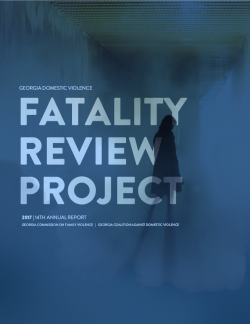
2017 Report
This is the 14th Annual Report released by the Georgia Domestic Violence Fatality Review Project (“the Project”). The Project is a statewide initiative that closely examines domestic violence-related fatalities. Since 2004, we have worked with 25 communities statewide to conduct in-depth fatality reviews. The Project aims to learn ways to more fully address the problem of domestic violence and to seek solutions to reduce the number of domestic violence-related deaths and injuries in our state. Read More
- 2016
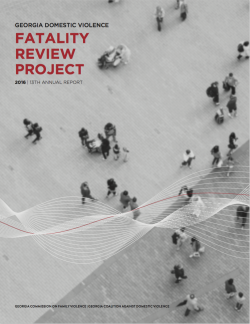
2016 Report
This year’s Annual Report focuses on our Project’s key finding regarding the suicide-homicide connection. This finding is driven by perpetrators attempting or completing suicide in 38% of the 105 domestic violence homicide cases reviewed by the Project. A domestic violence abuser’s level of depression as well as suicide threats and attempts are known to increase risk of injury for intimate partners, children and others. Evaluation of the Project’s 105 reviewed cases further revealed 37% of perpetrators had threatened or attempted suicide in incidents which occurred prior to the homicid Read More
- 2015
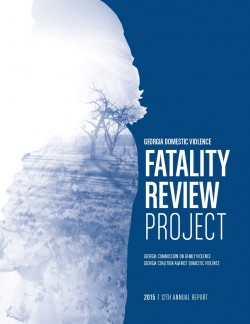
2015 Report
This Report features the story of Trisha, a young woman who lost her mother to domestic violence homicide at the tender age of 14. She shares what it was like to grow up in at home witnessing the abuse of the mother, what it was like the day her mother died, and how this devastating loss has impacted her throughout her life. Additional content includes the impact of domestic violence exposure on children, the impact that domestic violence-related homicide has on surviving children and families and a special look at the problem of murder-suicide and familicide. Read More
- 2014
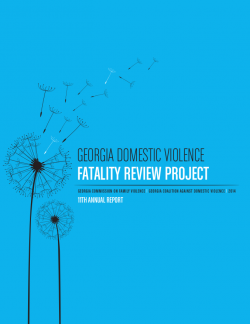
2014 Report
Content covers examples of communities working to address recommendations from the 10 key findings in the 2013 Report. Advocacy beyond leaving and engaging friends, family members, and other support systems in domestic violence advocacy are highlighted. Special sections include results from a survey on the Project and results from a survey on judicial notification of firearm prohibition. Read More
- 2013
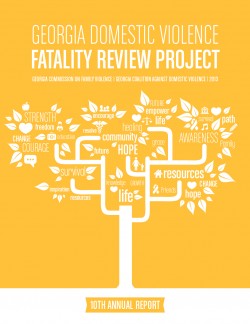
2013 Report
Content covers the 10 key findings from 10 years of fatality reviews, including children exposed to domestic violence; teen dating violence; economic abuse; the role of the criminal legal system; civil orders and the courts; firearms and fatalities; family, friends and the faith community; detachment, separation, and the risks of leaving; murder-suicides; and barriers to services for special populations. Special sections include when victims return/recant, what to do if someone you know is being abused, and domestic violence and the media. Read More
- 2012
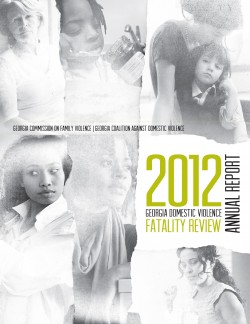
2012 Report
Content covers a story told by a near-fatality survivor, the intersections of animal abuse and domestic violence, economic abuse and child support, challenges with co-occurring issues of substance abuse and mental health, trauma-informed care, domestic violence and sexual abuse and a special section covering women’s use of violence. Read More
- 2011

2011 Report
Content covers escalating factors of lethal violence identified through fatality reviews, the impact of domestic violence fatalities on Georgia families and the Georgia Crime Victim’s Compensation Program, a snapshot of key findings, addressing domestic violence in the workplace, a follow-up on the faith initiative, and the release of the Roll Call Training Manual. Communities implementing recommendations and a tip sheet on safety planning with technology are featured. Read More
- 2010

2010 Report
Content covers findings around the need to re-frame domestic violence program services to the community, teen dating violence, a teen’s near-fatality story, the launching of the domestic violence in the workplace initiative, and a follow-up on the faith initiative. A special section highlighting the work of local communities training law enforcement is included as well as several tear outs that address safety planning with teens and resources for workplaces and faith communities. Read More
- 2009

2009 Report
Content focuses on the complexity of domestic violence, including victims allowing contact with abusers, substance abuse, and women’s use of violence, as well as secondary traumatic stress, isolation of victims, the roll of the faith community, and nine key areas of missed opportunities. Special sections include a highlight of a community implementing recommendations and a statewide interfaith summit on domestic violence. Read More
- 2008

2008 Report
Content covers the methodology of the Project, emerging themes from near fatalities, findings on where domestic violence victims are likely to disclose the abuse, insight into the lives of victims from friends and family members, promising practices of three communities in response to fatality review findings, and a section on the intersection of suicide and HIV of women experiencing domestic violence. A special section includes tips on what to do if you know someone who is being abused or abusive. Read More
- 2007

2007 Report
Content covers the methodology of the Project, a narrative of a near-fatality survivor, the dangers of leaving, firearms and domestic violence fatalities, the importance of information sharing between systems, domestic violence in the workplace, and the role of the faith community. A special section highlights what readers can do about domestic violence in their communities. Read More
- 2006

2006 Report
Content covers general findings of the Project, the methodology of fatality reviews and near-fatality reviews. In depth articles cover firearms and domestic violence fatalities, the impact of witnessing homicides on family members, dangerous factors known by the community prior to the homicide, suicide and depression in perpetrators, and civil and criminal history. Special sections include tools for everyone to use to address domestic violence and how communities are changing in response to fatality review findings. Read More
- 2005

2005 Report
Content covers the significant findings of the second year of the Project as well as updates to the methodology. Special sections include tips for safety planning with victims, highlights of communities implementing fatality review recommendations, the readers’ role in addressing domestic violence, and a discussion on the readiness of communities to participate in the Project. Read More
- 2004

2004 Report
Content covers the methodology of the Project, as well as the findings and recommendations to come out of the first year of reviews. Common barriers victims encountered, the role of community based systems, and legal systems are discussed in depth. Communities already being transformed by recommendations are highlighted. Read More
